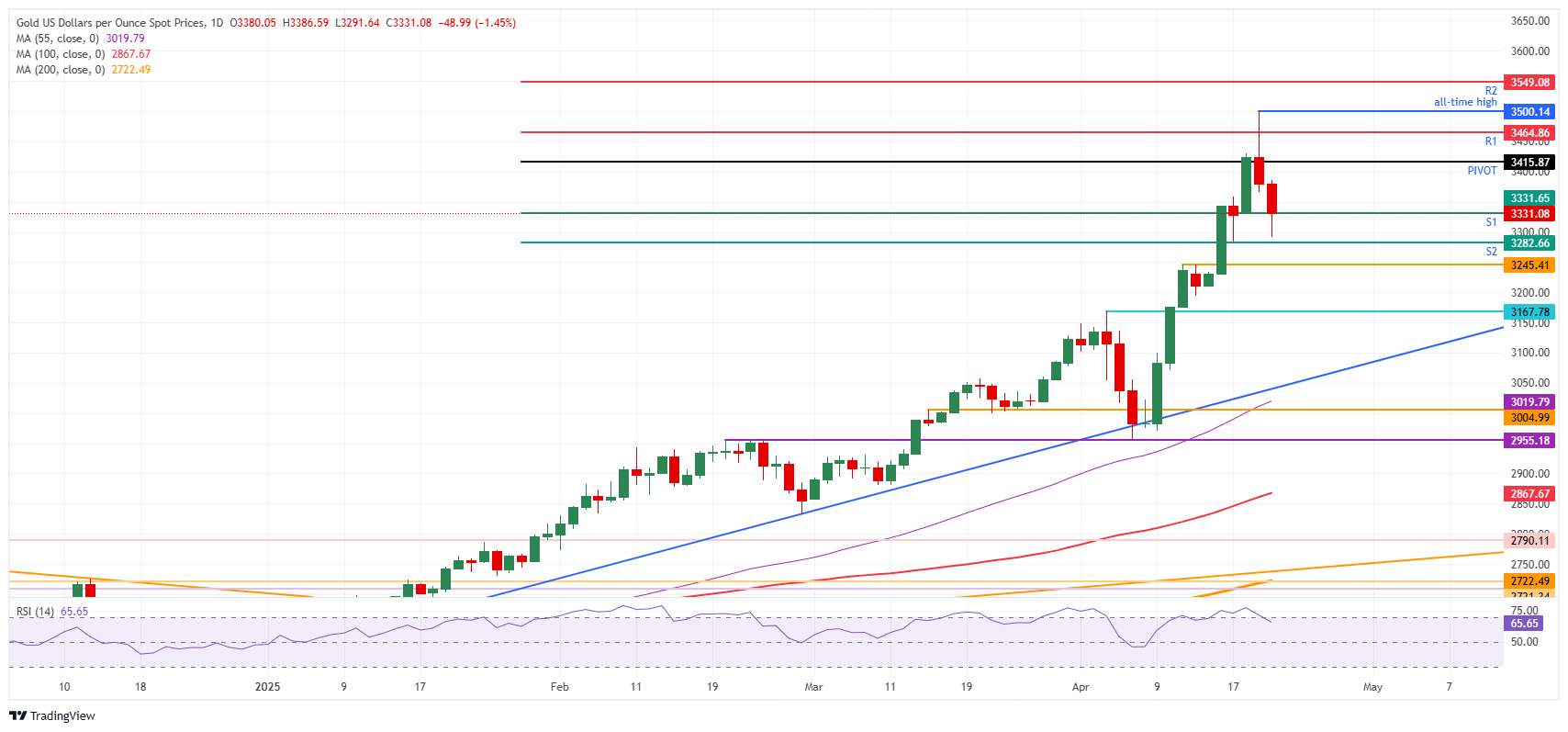Gold price falls further as Trump softens tone on Powell
- Gold price sees a 5% decline after hitting a new all-time high at $3,500 on Tuesday.
- US President Trump backtracks on earlier statements and hints at lower tariffs for China and backs down from his threats of firing Fed’s Powell.
- Markets buy into the turnaround, with equities and bonds higher.
Gold price (XAU/USD) is facing profit-taking pressure and nosedives on Wednesday towards $3,300 at the time of writing. The profit taking picked up on comments from United States (US) President Donald Trump, who did a 180-degree turn on his stance on China and the Federal Reserve (Fed). After the closing bell, Tesla’s (TSLA) Chief Executive Officer Elon Musk said he will reduce his role at the Department of Government Efficiency (DOGE).
President Trump rebuked earlier statements in which he was seeking to fire Fed Chair Jerome Powell to say now that he has no intention to fire him despite his frustration with the Fed not moving more quickly with the interest rate cuts, the Wall Street Journal reported. The president went on to say that he will be “very nice” to China in any trade talks and that tariffs will drop if the two countries can reach a deal. Final tariffs on China would not be near 145%, but much lower, he said, Bloomberg reports.
Daily digest market movers: Gold inversed with Bitcoin
- Gold has dipped in relation to Bitcoin this week, but its long-term trend of outperformance is expected to extend on demand for its safe-haven qualities. Investors will be expecting more sound bites from US leaders, which will muddy the outlook in the days ahead, Bloomberg reports.
- Central banks will keep buying Gold in a push to diversify from paper currencies amid the current political and economic upheaval, according to billionaire hedge-fund manager John Paulson, Reuters reports.
- “Gold’s tactically very overbought and extended - it’s risen $500 plus in 8 trading days, so naturally there’s likely a mix of a buyers’ pause and some risk reduction,” said Nicky Shiels, head of research and metals strategy at MKS Pamp SA, Bloomberg reports.
Gold Price Technical Analysis: Some profit taking at hand
The precious metal sees its Relative Strength Index (RSI) come back in the normal trading range after having spent several days in the overbought area. Some more profit taking would make sense given the softer rhetoric from President Trump. Currently at around 63, it would make sense for the RSI to fall back to 50 with the Gold price probably looking for support near $3,167, the pivotal level from early April.
The daily Pivot Point on the upside at $3,415 is the first level of resistance, which is quite far away and would mean Gold reverses in full and even turns positive on the day. Such a move would push the RSI back into overbought territory. Further up, the next resistance comes in at $3,464.
On the downside, the first support is at $3,331, which already broke in early trading. Look at least for a test on the S2 at $3,282, which coincides with the April 17 low. Below, the pivotal level from early April should catch the traders’ attention as well at $3,167.

XAU/USD: Daily Chart
Gold FAQs
Gold has played a key role in human’s history as it has been widely used as a store of value and medium of exchange. Currently, apart from its shine and usage for jewelry, the precious metal is widely seen as a safe-haven asset, meaning that it is considered a good investment during turbulent times. Gold is also widely seen as a hedge against inflation and against depreciating currencies as it doesn’t rely on any specific issuer or government.
Central banks are the biggest Gold holders. In their aim to support their currencies in turbulent times, central banks tend to diversify their reserves and buy Gold to improve the perceived strength of the economy and the currency. High Gold reserves can be a source of trust for a country’s solvency. Central banks added 1,136 tonnes of Gold worth around $70 billion to their reserves in 2022, according to data from the World Gold Council. This is the highest yearly purchase since records began. Central banks from emerging economies such as China, India and Turkey are quickly increasing their Gold reserves.
Gold has an inverse correlation with the US Dollar and US Treasuries, which are both major reserve and safe-haven assets. When the Dollar depreciates, Gold tends to rise, enabling investors and central banks to diversify their assets in turbulent times. Gold is also inversely correlated with risk assets. A rally in the stock market tends to weaken Gold price, while sell-offs in riskier markets tend to favor the precious metal.
The price can move due to a wide range of factors. Geopolitical instability or fears of a deep recession can quickly make Gold price escalate due to its safe-haven status. As a yield-less asset, Gold tends to rise with lower interest rates, while higher cost of money usually weighs down on the yellow metal. Still, most moves depend on how the US Dollar (USD) behaves as the asset is priced in dollars (XAU/USD). A strong Dollar tends to keep the price of Gold controlled, whereas a weaker Dollar is likely to push Gold prices up.

